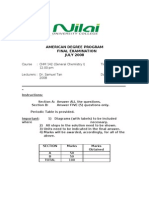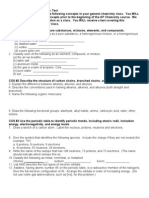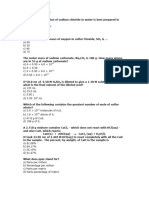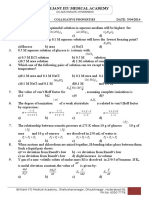0 ratings0% found this document useful (0 votes)
123 viewsSt00502 Basic Chemistry Assignment 1 Answer All of The Questions
St00502 Basic Chemistry Assignment 1 Answer All of The Questions
Uploaded by
Ori LukeThis document contains a chemistry assignment with 10 questions covering various chemistry concepts such as solutions, molecular formulas, reaction stoichiometry, quantum numbers, Lewis structures, concentrations, and parts per million/billion. Students are asked to calculate quantities related to solutions, determine molecular formulas, describe preparation of solutions, perform stoichiometric calculations for a chemical reaction, determine quantum numbers for atomic orbitals, draw Lewis structures, calculate molarity from concentration percentages, and convert between parts per million/billion and molarity. The assignment is due on March 4, 2013 and is worth a total of 60 marks.
Copyright:
© All Rights Reserved
Available Formats
Download as DOC, PDF, TXT or read online from Scribd
St00502 Basic Chemistry Assignment 1 Answer All of The Questions
St00502 Basic Chemistry Assignment 1 Answer All of The Questions
Uploaded by
Ori Luke0 ratings0% found this document useful (0 votes)
123 views2 pagesThis document contains a chemistry assignment with 10 questions covering various chemistry concepts such as solutions, molecular formulas, reaction stoichiometry, quantum numbers, Lewis structures, concentrations, and parts per million/billion. Students are asked to calculate quantities related to solutions, determine molecular formulas, describe preparation of solutions, perform stoichiometric calculations for a chemical reaction, determine quantum numbers for atomic orbitals, draw Lewis structures, calculate molarity from concentration percentages, and convert between parts per million/billion and molarity. The assignment is due on March 4, 2013 and is worth a total of 60 marks.
Original Description:
Assignment 1
Original Title
Assignment 1
Copyright
© © All Rights Reserved
Available Formats
DOC, PDF, TXT or read online from Scribd
Share this document
Did you find this document useful?
Is this content inappropriate?
This document contains a chemistry assignment with 10 questions covering various chemistry concepts such as solutions, molecular formulas, reaction stoichiometry, quantum numbers, Lewis structures, concentrations, and parts per million/billion. Students are asked to calculate quantities related to solutions, determine molecular formulas, describe preparation of solutions, perform stoichiometric calculations for a chemical reaction, determine quantum numbers for atomic orbitals, draw Lewis structures, calculate molarity from concentration percentages, and convert between parts per million/billion and molarity. The assignment is due on March 4, 2013 and is worth a total of 60 marks.
Copyright:
© All Rights Reserved
Available Formats
Download as DOC, PDF, TXT or read online from Scribd
Download as doc, pdf, or txt
0 ratings0% found this document useful (0 votes)
123 views2 pagesSt00502 Basic Chemistry Assignment 1 Answer All of The Questions
St00502 Basic Chemistry Assignment 1 Answer All of The Questions
Uploaded by
Ori LukeThis document contains a chemistry assignment with 10 questions covering various chemistry concepts such as solutions, molecular formulas, reaction stoichiometry, quantum numbers, Lewis structures, concentrations, and parts per million/billion. Students are asked to calculate quantities related to solutions, determine molecular formulas, describe preparation of solutions, perform stoichiometric calculations for a chemical reaction, determine quantum numbers for atomic orbitals, draw Lewis structures, calculate molarity from concentration percentages, and convert between parts per million/billion and molarity. The assignment is due on March 4, 2013 and is worth a total of 60 marks.
Copyright:
© All Rights Reserved
Available Formats
Download as DOC, PDF, TXT or read online from Scribd
Download as doc, pdf, or txt
You are on page 1of 2
Due Date: Week 7 (3/4/2013)
ST00502 BASIC CHEMISTRY
ASSIGNMENT 1
Answer all of the questions.
1. A solution is 40.0% acetic acid (the characteristic component in vinegar) by mass. The
density of this solution is 1.049g/mL at 20C. Calculate the mass of pure acetic acid in
150.0mL of this solution at 20C.
(3
marks)
2. Determine the molecular formula of a compound that contains 26.7% P, 12.1% N and
61.2% Cl, and has a molar mass of 580 g/mol.
(7 marks)
3. Describe how you would prepare 2.00 L of each of the following solutions.
0.250 M NaOH from solid NaOH.
a.
0.250 M NaOH from 1.00 M NaOH stock solution.
b.
0.10 M K2CrO4 from solid K2CrO4
c.
0.10 M K2CrO4 from 1.75 M K2CrO4 stock solution.
d.
(8
marks)
4. DDT, an insecticide harmful to fish, birds and humans, is produced by the following
reaction:
2C6H5Cl + C2HOCl3 C14H9Cl5 + H2O
Chlorobenzene
Chloral
DDT
In a government lab, 1142 g of chlorobenzene is reacted with 485 g of chloral.
a. What mass of DDT is formed, assuming 100% yield?
b. Which reactant is limiting? Which is in excess?
c. What mass of the excess reactant is left over?
d. If the actual yield of DDT is 200.0 g, what is the percent yield?
(10
marks)
5. Chloral hydrate (C2H3Cl3O2) is a drug formerly used as a sedative and hypnotic. It is the
compound used to make Mickey Finns in detective stories.
a. Calculate the molar mass of chloral hydrate.
b. How many moles of C2H3Cl3O2 molecules are in 500.0 g of chloral hydrate?
c. What is the mass in grams of 0.02 mol chloral hydrate?
d. How many chlorine atoms are in 5.0 g chloral hydrate?
e. What mass of chloral hydrate would contain 1.0 g Cl?
f. What is the mass of exactly 500 molecules of chloral hydrate?
(15
marks)
6. a. What is a quantum number? What is an atomic orbital?
b. How many quantum numbers are required to specify a single atomic orbital? What are
they?
(4 marks)
7. Write a complete set of quantum numbers (n, l and ml) for each of the following orbitals:
a. 5f
1/2
Due Date: Week 7 (3/4/2013)
b. 4d
c. 2s
marks)
(6
8. Write Lewis structures for the following molecules or ions:
POCl3
a.
ClO4b.
PO33c.
XeO4
d.
(4 marks)
9. Commercially available concentrated hydrochloric acid is 37% w/w. Its density is
1.18g/ml. Use this information to calculate:
a. The molarity of concentrated hydrochloric acid
(3 marks)
b. The volume (in milliliters) of solution containing 0.315 mole of HCl
(2 marks)
10. The units of parts per million (ppm) and parts per billion (ppb) are commonly used by
environmental chemists. In general, 1 ppm means 1 part of solute for every 10 6 parts of
solution (both solute and solution are measured using the same units). Mathematically, by
mass:
ppm = g solute = mg solute
g solution
kg solution
In the case of very dilute aqueous solutions, a concentration of 1.0 ppm is equal to 1.0 g
of solute per 1.0 mL of solution, which equal 1.0 g solution. Parts per billion is defined in
a similar fashion. Calculate the molarity of each of the following aqueous solutions:
a.
5.0 ppb Hg in H2O.
b.
1.0 ppb CHCl3 in H2O.
c.
10.0 ppm As in H2O.
d.
0.10 ppm DDT (C14H9Cl5) in H2O.
(12 marks)
2/2
You might also like
- Ecotank l5296 DatasheetDocument2 pagesEcotank l5296 DatasheetIulian ChirilăNo ratings yet
- CBRC Mock Let 2020Document95 pagesCBRC Mock Let 2020Kimberly Mae Dela Cruz Rael100% (2)
- AP Chemistry Chapter 4 TestDocument3 pagesAP Chemistry Chapter 4 Testphysteach1216100% (2)
- Tutorial 1 Chm256Document2 pagesTutorial 1 Chm256ANIS AMIRAH SALIMINNo ratings yet
- CHM421 Assignment QuestionDocument3 pagesCHM421 Assignment Questionaremyrah AzlanNo ratings yet
- Tutorial Chm256 Chapter1 (Part 2)Document2 pagesTutorial Chm256 Chapter1 (Part 2)Siti Suhailah100% (1)
- Practice Quiz 01Document4 pagesPractice Quiz 01Joseph FruitNo ratings yet
- JEE - Chemistry - Mole ConceptDocument26 pagesJEE - Chemistry - Mole Conceptofficial.archit234No ratings yet
- Assignment (Some Basic Concept of Chemistry) - 4 PDFDocument4 pagesAssignment (Some Basic Concept of Chemistry) - 4 PDFJatin SinglaNo ratings yet
- Mole Concept Confidence Building Test1Document12 pagesMole Concept Confidence Building Test11harshikaNo ratings yet
- SolutionsDocument3 pagesSolutionskingjgiridharNo ratings yet
- 2024 04 27 0.7210120086987455Document3 pages2024 04 27 0.7210120086987455boymuffin588No ratings yet
- Mole Concept DPP 4Document2 pagesMole Concept DPP 4iitmohakNo ratings yet
- Tutorial DACS1232 AllDocument6 pagesTutorial DACS1232 Allluqman04hakimiNo ratings yet
- Mole Concept - AssDocument2 pagesMole Concept - AssAãrøn KâtøñgôNo ratings yet
- S2 Final Exam Revision SheetDocument21 pagesS2 Final Exam Revision Sheethbye1372No ratings yet
- Formula Mass and Mole ConceptDocument6 pagesFormula Mass and Mole ConceptGottfried Wilhelm LeibnizNo ratings yet
- Mole Concept Solution Practice Set ObjectiveDocument3 pagesMole Concept Solution Practice Set ObjectiveGagandeep SinghNo ratings yet
- CHM142 Final July 2008Document11 pagesCHM142 Final July 2008Lee_Moi_Yeoh_6863No ratings yet
- DPP # 1 - 8 Physical ChemistryDocument5 pagesDPP # 1 - 8 Physical ChemistrySankar KumarasamyNo ratings yet
- Chem 11 Mole Review Ch3 PDFDocument4 pagesChem 11 Mole Review Ch3 PDFCarl Agape DavisNo ratings yet
- AP Summer Review PacketDocument5 pagesAP Summer Review PacketAndreaMarkhamNo ratings yet
- Tutorial 3Document1 pageTutorial 3poddapandiNo ratings yet
- Tutorial CHM 207 Chapter 1Document2 pagesTutorial CHM 207 Chapter 1tiqahNo ratings yet
- Chem Biol Probset 1Document1 pageChem Biol Probset 1siahjocsonNo ratings yet
- Tutorial 3-3-Solution PDFDocument2 pagesTutorial 3-3-Solution PDFChoy BeiyeeNo ratings yet
- Chapter 9 ReviewerDocument4 pagesChapter 9 ReviewerMichael Cataluna0% (2)
- ProbSet 3 Chap 3Document2 pagesProbSet 3 Chap 3Gabriel SosobanNo ratings yet
- Soal KFD FriardiDocument1 pageSoal KFD FriardiRani PuspitaNo ratings yet
- Exam 4b Chem 120 Spring 2013Document7 pagesExam 4b Chem 120 Spring 2013ASEELNo ratings yet
- ReviewDocument7 pagesReviewyan45411No ratings yet
- BT HPTDocument14 pagesBT HPTNhậtt VyNo ratings yet
- Midterm Preparation DocumentDocument15 pagesMidterm Preparation DocumentbettieboomNo ratings yet
- AP Macro NotesDocument3 pagesAP Macro Notesichaewon557No ratings yet
- Unit 1 Some Basic Hy WorksheetDocument4 pagesUnit 1 Some Basic Hy WorksheetBellatrix LestrangeNo ratings yet
- CH 5 MCQsDocument5 pagesCH 5 MCQspha.ahm.najjarNo ratings yet
- Che115b Assignment 1 18 Mar 2024 (Updated) - 2Document3 pagesChe115b Assignment 1 18 Mar 2024 (Updated) - 2Mushavhi RudziNo ratings yet
- 2024 SCHM011 Test2 (Memo)Document9 pages2024 SCHM011 Test2 (Memo)tshegofatsomolapo015No ratings yet
- Sample Problem 102 P 309Document7 pagesSample Problem 102 P 309sadin alkafNo ratings yet
- LT # 1 (Composition Stoichiometry) & Reaction StoichiometryDocument3 pagesLT # 1 (Composition Stoichiometry) & Reaction StoichiometryANONNNo ratings yet
- Mole Lecture Tutorial - 1536082279 PDFDocument6 pagesMole Lecture Tutorial - 1536082279 PDFGlacier RamkissoonNo ratings yet
- Physical Chemistry: Shailendra KRDocument6 pagesPhysical Chemistry: Shailendra KR1harshikaNo ratings yet
- Question Bank in Chemistry Class ADocument81 pagesQuestion Bank in Chemistry Class AiliasNo ratings yet
- CHE 110 Exam 2 F'13 v1Document6 pagesCHE 110 Exam 2 F'13 v1MicahNo ratings yet
- Some Basic Concept of Chemistry: Chapter - 01Document7 pagesSome Basic Concept of Chemistry: Chapter - 01MidhunNo ratings yet
- Chemistry MCQDocument26 pagesChemistry MCQArun Sharma0% (1)
- CHE1031 HW Set 3: Composition of Substances & Solutions - KEYDocument5 pagesCHE1031 HW Set 3: Composition of Substances & Solutions - KEYMargene SmithNo ratings yet
- Malayan Colleges Laguna Mapua Institute of Technology at LagunaDocument18 pagesMalayan Colleges Laguna Mapua Institute of Technology at LagunaAlyssa ApolinarioNo ratings yet
- Sep 2011 REE PreBoard Exam ESAS3Document2 pagesSep 2011 REE PreBoard Exam ESAS3Bugoy2023No ratings yet
- Iitian Sushil Kumar: B.Tech Iit Madras M.Tech Iit MadrasDocument3 pagesIitian Sushil Kumar: B.Tech Iit Madras M.Tech Iit MadrasprernashaluNo ratings yet
- Chemistry Test t1 Q Neet Test 5Document16 pagesChemistry Test t1 Q Neet Test 5SahanaaNo ratings yet
- HW 1Document13 pagesHW 1Abdullah AlotaibiNo ratings yet
- DPP 1Document10 pagesDPP 1Phani PadmasriNo ratings yet
- CHE1031 Exam 2: Moles Through Stoichiometry & Quantitative Analysis KEYDocument5 pagesCHE1031 Exam 2: Moles Through Stoichiometry & Quantitative Analysis KEYTG17 NobleNo ratings yet
- Chemistry Practice Exam-#3Document22 pagesChemistry Practice Exam-#3Hanna Belle GoreNo ratings yet
- Mole Concept AssignmentDocument14 pagesMole Concept AssignmentmunasinghNo ratings yet
- Exam Module B6 "Hydrochemistry" Thursday 11.04.2008, 10am - 1pmDocument4 pagesExam Module B6 "Hydrochemistry" Thursday 11.04.2008, 10am - 1pmΒενιαμίν στέμμαNo ratings yet
- DPP For Jee Daily Practice Problems CH 1: Some Basic Concepts of ChemistryDocument7 pagesDPP For Jee Daily Practice Problems CH 1: Some Basic Concepts of Chemistryhcvy7zbjs6No ratings yet
- Experiment (HB) ( Mol/l) (CO) ( Mol/l) Initial Rate ( Mol L S)Document1 pageExperiment (HB) ( Mol/l) (CO) ( Mol/l) Initial Rate ( Mol L S)Ori LukeNo ratings yet
- ZN ZN + 2e E +0.76 Cu + 2e Cu E +0.34Document3 pagesZN ZN + 2e E +0.76 Cu + 2e Cu E +0.34Ori LukeNo ratings yet
- Experiment (HB) ( Mol/l) (CO) ( Mol/l) Initial Rate ( Mol L S)Document2 pagesExperiment (HB) ( Mol/l) (CO) ( Mol/l) Initial Rate ( Mol L S)Ori LukeNo ratings yet
- St00502 Basic Chemistry Assignment 2 Answer All of The QuestionsDocument2 pagesSt00502 Basic Chemistry Assignment 2 Answer All of The QuestionsOri LukeNo ratings yet
- Question 5Document1 pageQuestion 5Ori LukeNo ratings yet
- Orthogonal Coordinate SystemsDocument4 pagesOrthogonal Coordinate SystemsMahesh ValaNo ratings yet
- Review of Multicomponent and Multilayer Coatings For TribologicalDocument11 pagesReview of Multicomponent and Multilayer Coatings For TribologicalFernando Spanholi TelesNo ratings yet
- Template Masterpiece - Bahasa IndonesiaDocument4 pagesTemplate Masterpiece - Bahasa IndonesiaAl-Ghafur ChannelNo ratings yet
- Proceedings of The Fifth International Groundwater Conference (IGWC-2012)Document43 pagesProceedings of The Fifth International Groundwater Conference (IGWC-2012)prijucpNo ratings yet
- Cambridge International General Certificate of Secondary EducationDocument16 pagesCambridge International General Certificate of Secondary EducationDipto RoyNo ratings yet
- Thesis Statement On Memory LossDocument8 pagesThesis Statement On Memory Lossrebeccabuonocambridge100% (2)
- Hemal CVDocument2 pagesHemal CVHemal KuraniNo ratings yet
- CTSH - Technical Bulletin 97-1Document4 pagesCTSH - Technical Bulletin 97-1hesigu14No ratings yet
- 8p+2q+7r - SolutionDocument1 page8p+2q+7r - SolutionFelix TzoyNo ratings yet
- Tips For Managing ADHDDocument1 pageTips For Managing ADHDe.toledoNo ratings yet
- 2400 Xenolith v1.7 SpreadsDocument2 pages2400 Xenolith v1.7 SpreadslautaroNo ratings yet
- Composite Materials in Aerospace Applications PDFDocument10 pagesComposite Materials in Aerospace Applications PDFYustinus KrisnaNo ratings yet
- Quarter 1 - Module 1: Introduction To Media and Information LiteracyDocument40 pagesQuarter 1 - Module 1: Introduction To Media and Information LiteracyMario Reynaldo CicatNo ratings yet
- DNA - and RNA-Based Computing SystemsDocument397 pagesDNA - and RNA-Based Computing SystemsAgustin BarrientosNo ratings yet
- Siddika Shafinaz Sorna: ContactDocument2 pagesSiddika Shafinaz Sorna: Contactamcbd2019No ratings yet
- Ps 1Document2 pagesPs 1Ram Balaji100% (1)
- R5 EMERGENCY LIGHT 2nD FLRDocument1 pageR5 EMERGENCY LIGHT 2nD FLRAlsean Soriano DetubioNo ratings yet
- David Finnigan’s Kill Climate Deniers (2018)Document2 pagesDavid Finnigan’s Kill Climate Deniers (2018)S. m.s.No ratings yet
- Humanoid RobotsDocument28 pagesHumanoid Robotsneethu_20No ratings yet
- Book Summary - I Hear You Summary Michael Sorensen - Read in 7 MinutesDocument10 pagesBook Summary - I Hear You Summary Michael Sorensen - Read in 7 MinutesNogüey JoseNo ratings yet
- DLL - Science 5 - Q1 - W7Document7 pagesDLL - Science 5 - Q1 - W7Maritess SilvestreNo ratings yet
- Grade Card: Second Semester June 2019Document2 pagesGrade Card: Second Semester June 2019ANMOL DUTTNo ratings yet
- English Final X - EditedDocument157 pagesEnglish Final X - EditedSuhani GosainNo ratings yet
- 6503822143-000500 CD DocsDocument63 pages6503822143-000500 CD DocsCristopher ReyesNo ratings yet
- Sample Questions On Polarization of LightDocument3 pagesSample Questions On Polarization of Lightssmukherjee2013No ratings yet
- Text Books FullDocument1 pageText Books FullporkovanNo ratings yet
- Campus Recruitment TestDocument2 pagesCampus Recruitment TestPriyanshu SinghNo ratings yet
- 08 - 05.2021-Problems in Vietnamese-English Translation of Relative Clauses For English-Majored Juniors at Tay Do University, Vietnam PDFDocument10 pages08 - 05.2021-Problems in Vietnamese-English Translation of Relative Clauses For English-Majored Juniors at Tay Do University, Vietnam PDFLe LanhNo ratings yet






























































































